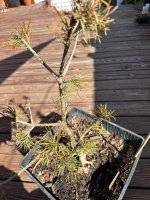Troutnut
Seedling
I’m in need of advice regarding my JWP ‘Glauca’—I’ve had it going strong for ~8 months without issue until I decided to repot into a larger pond basket.
The images are from several weeks ago after I pinched off some dying-looking tips (browning of needles, dark coloration at tips). In fear, I repotted back down to a smaller pond basket with significantly less organic media, added mycorrhizae, and layered volcanic rock beneath and on top of the substrate. Reddit “experts” informed me that my tree is dead, as JWPs are indeed brutal in their retribution for poor care.
What confounds me is that the phloem appears to be in full vigor—scratches at any point of the tree, even on a now-bare branch, produce
vibrant green phloem and ordinary sap release. The color under bark has had the same healthy appearance before and after the emergency repot.
For further information where it isn’t obvious—this tree has lived under consistent sun on a south-facing porch, where I suspect that it must have experienced root rot due to overpotting and overwatering due to excess rainfall without refuge. When I repotted, I investigated the roots and found some weakness and rot, but largely healthy root material. I avoided total removal of soil around the roots, but I did encourage some spread as I repotted. Further, I have treated this tree with spinosad, neem oil, and full spectrum fungicide without negative effect throughout the summer.
Do any practiced pine-keepers have any input for me? Does this look like disease or is it a symptom of root rot? Could this tree recover with proper potting? Would it be best to place the tree in sphagnum to attempt to recover, or should I leave it in my largely inorganic/minimally organic substrate?
Edit: photos are from before the repot.
The images are from several weeks ago after I pinched off some dying-looking tips (browning of needles, dark coloration at tips). In fear, I repotted back down to a smaller pond basket with significantly less organic media, added mycorrhizae, and layered volcanic rock beneath and on top of the substrate. Reddit “experts” informed me that my tree is dead, as JWPs are indeed brutal in their retribution for poor care.
What confounds me is that the phloem appears to be in full vigor—scratches at any point of the tree, even on a now-bare branch, produce
vibrant green phloem and ordinary sap release. The color under bark has had the same healthy appearance before and after the emergency repot.
For further information where it isn’t obvious—this tree has lived under consistent sun on a south-facing porch, where I suspect that it must have experienced root rot due to overpotting and overwatering due to excess rainfall without refuge. When I repotted, I investigated the roots and found some weakness and rot, but largely healthy root material. I avoided total removal of soil around the roots, but I did encourage some spread as I repotted. Further, I have treated this tree with spinosad, neem oil, and full spectrum fungicide without negative effect throughout the summer.
Do any practiced pine-keepers have any input for me? Does this look like disease or is it a symptom of root rot? Could this tree recover with proper potting? Would it be best to place the tree in sphagnum to attempt to recover, or should I leave it in my largely inorganic/minimally organic substrate?
Edit: photos are from before the repot.


